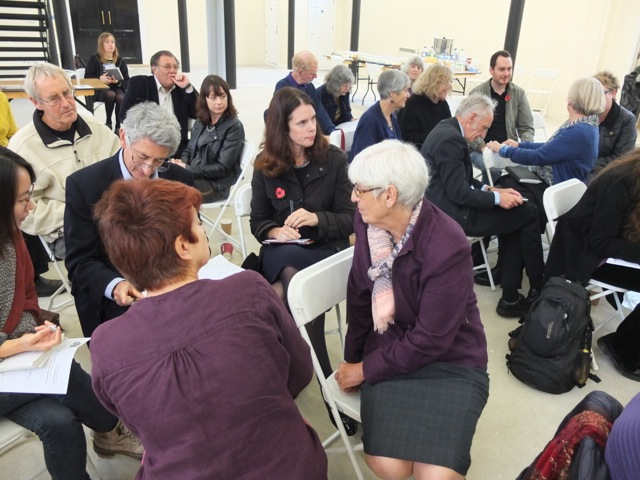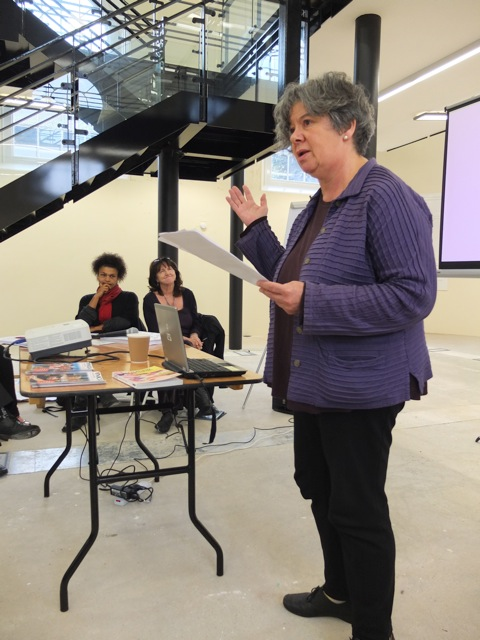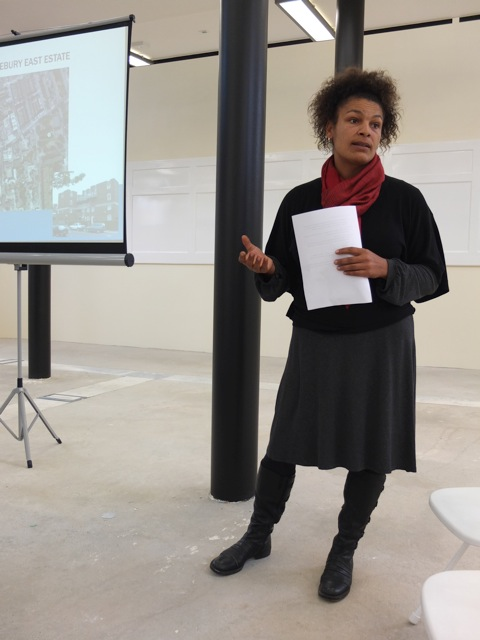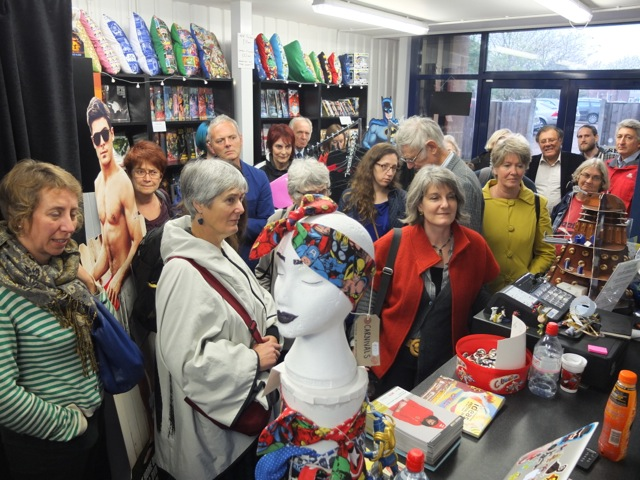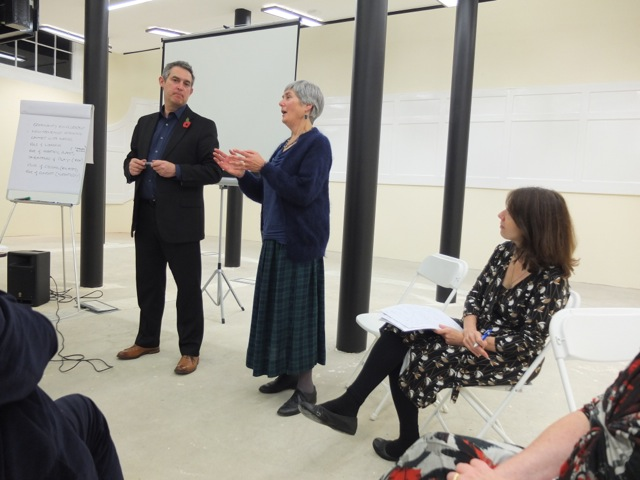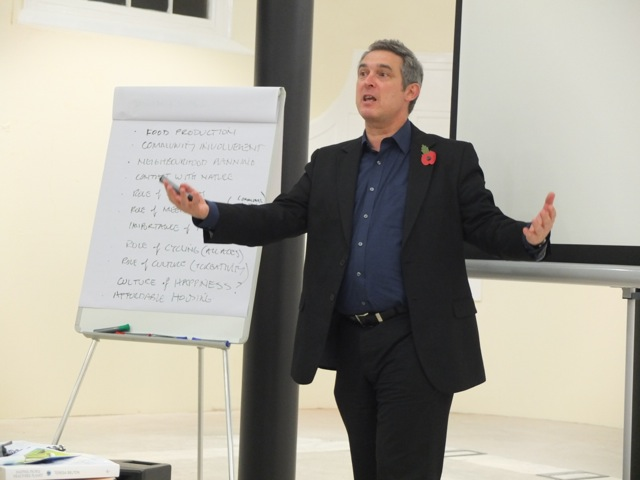The focus of this year’s Chelmsford Ideas Festival was ‘create’ – explored through a multitude of activities, for all ages. As a part of the festival the Academy hosted a day comprised of three complimentary events — which looked to explore links between city life, creativity, health and well-being. The event was facilitated by AoU regional convenor, and urban designer at Chelmsford Council, Roger Estop.
The resounding questions and overarching theme for the day itself was: ‘What makes a happy city?’, with mental well-being positioned at the very heart of the discussion. Surpassing mere discussion however, there was a continued practical impetus to the day, with audiences asked to consider how ideas of engendering civic happiness could be integrated into policy making. Moreover, those in the audience possessing ‘pull’ in the necessary, decision-making, spheres – developers and policy-makers – were oft called upon to relay-on comments emergent from the discussion, demonstrating a drive to see that these ideas were granted a legacy.
The newly (and ‘sensitively’) renovated Anne Knight Building served as the base for the day, as provided by Genesis housing group. Notably so, as the namesake of the building, Knight – a revolutionary Quaker and feminist – emerged as a leading theme and inspirational source throughout the unfolding discussion.
The Academy’s own John Worthington chaired the first of the events, Creating a Happy City Seminar, leading with key questions, including: ‘What do we want our city to be?’, ‘What is the role of a citizen?’, ‘How can we foster a sense of belonging and ownership?’ Following, this Phil Martin of the YMCA took to the floor, and poignantly he reiterated throughout his talk the disparity in focus between ‘building houses’ and ‘building communities’, the latter of which is, comparatively speaking, scarcely addressed.
Next, Jane Wernick, editor of Building Happiness: Architecture to Make You Smile, discussed ideas of how to quantify subjective well-being and happiness. Wernick, putting forward an evidence-based approach – that could work to allow resultant data to potentially influence policy making.
Ex-housing manager Lynne Foster talked of the Press as an influential factor in determining people’s happiness in an area – expressing that, the damming of a neighbour in the Media can work to reduce housing prices and to increase levels of anxiety within residents. The key suggestions put forward by Lynne for engendering mental well-being, in terms of housing, included: tenure-mix, open space, sunlight, minimal interference from maintenance bodies, community hubs, shared-responsibility and opportunities for resident involvement.
Ruth Marie Tunkara followed with an engaging account of the important work carried out by the Quaker Social Action in the Knees-Up project, and specifically on the Avebury East estate in East London – once an underused and quite closed community with limited services and very little interaction between neighbours. Ruth described their asset based approach to development, in which stage one was to seek out community ‘Connectors’ in the area — the most active and engaged residents – the first wave of participators, that would then branch out and bring more in. This led onto the instigation of a weekly drop in session, coined the ‘Neighbours’ Lounge’ – sessions in which residents would come together to share ideas or concerns, and to plan activities such as cooking sessions, parties and excursions. In this way the lounge acted as a free space, given up for the community, and thus enabling it the physical space to develop and strengthen.
Ruth then elaborated on many of the positive outcomes from the project: a rise in inter-generational and cross cultural interactions and increased levels of trust, communication and sharing within the community. One of the key ideas conveyed by Ruth was the importance in allowing residents to come together to negotiate, and to hash out the shape of their own community collectively — and in this way, the function of the Quakers was to trigger and to then enable and facilitate this activity, which was essentially coming from within.
After having touched on more of the theoretical underpinnings for the day in the seminar and resultant discussion, Roger Estop took the audience out ‘on-the-ground’ – leading the group, consisting primarily of Architects, Urbanists, local activists and students to visit some of the creative industries currently occupying the units under the railway arches along Viaduct Road. Roger led discussions with the people behind the businesses along the way, thus allowing audiences to hear the voices of those at the heart of the discussion: Chelmsford locals. Each visit and discussion with the proprietors working to support the idea that local businesses, like these, can develop an economic sector that supports and nurtures a sense of community – by giving physical space for communities of interest to congregate, whom might otherwise be restricted to meeting solely online.
The capability of the arts as a way to embed meaning into place, or to highlight the pre-existing, was a recurrent point of discussion throughout the day. Guest speakers, including public artists and those working in participatory community arts, shone light on the ways in which the arts and urban redevelopments projects can work to strengthen one another.
The event closed with a panel discussion, led by director of The Academy of Urbanism, Kevin Murray. Murray opened by referencing Scandinavian countries, namely Aarhus, as those we can look to for inspiration, for their progressive approach towards wellbeing.
Teresa Belton, the first speaker on the panel, opened by talking about the link between personal happiness and global sustainability, based on her extensive research of people living modest lifestyles. Followed by Sue Riddleston who opened by making reference to the results of a recent nationwide survey: ‘Did you know Chelmsford is the happiest place in Britain?’ Riddlestone, advocated a mantra of ‘one planet living’ – essentially, that we should all take more than our fair share from this planet, and take on responsibility for giving something back.
The ideas emergent from this section of the day included: the notion that education needs to enable children the space to experiment, the importance of community dialogues and the desire for a mode of community engagement that enables pro-active, formative involvement – rather than that which is reactive.
The event, and day, concluded with Kevin taking a vote as to what the audience felt was the most important factor, out of the many discussed and that should be taken forward into policy, in terms of promoting wellbeing — those coming out on top being: culture and creativity, cycling, affordable housing, and finally – happiness.
Words by Katy Hawkins
